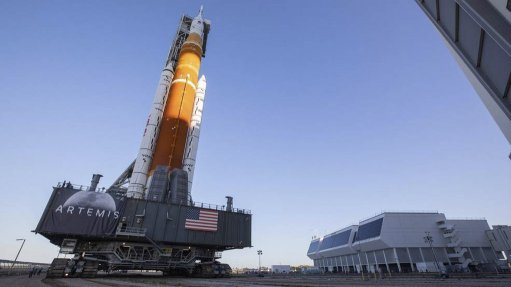
The complete Artemis I rocket, on the crawler transporter, photographed earlier this year
Photo by: Nasa
The US space agency, the National Aeronautics and Space Administration (Nasa), commenced the roll-out, on its crawler transporter, of the complete Artemis I Moon rocket at about 06h10 South African time (00h10 US Eastern Daylight Time) on Monday, from the Vehicle Assembly Building (VAB) to Launch Pad 39B, at the Kennedy Space Centre (KSC, in the US State of Florida) for its next ‘wet dress rehearsal’ test. The launch pad lies nearly 6.5 km (four miles) from the VAB.
The Artemis I is composed of the Orion spacecraft and the Space Launch System (SLS) rocket. The first attempt at a wet dress rehearsal, in April, encountered a series of problems, reportedly mainly with ground equipment and systems, forcing Nasa to halt it and return the Moon rocket to the VAB.
The wet dress rehearsal is a crucial step in the process of preparing the rocket for launch. During the test, the complete rocket is placed on the launch pad and the Artemis launch team run through the complete process of filling the SLS’ tanks with nearly 2.65-million litres of cryogenic propellant (liquid hydrogen and liquid oxygen) and conduct a full launch countdown, practising launch procedures and timelines. Power will be supplied to a number of spacecraft and rocket systems, and to ground support equipment.
The rehearsal includes activating KSC’s Launch Control Centre and establishing communications links with Nasa Mission Control Centre at the Johnson Space Centre in Houston (in Texas), the SLS Engineering Support Centre (at the Marshall Space Flight Centre in Huntsville, in Alabama) and the US Space Force’s Eastern Range.
The Launch Control Centre will take the countdown to the point just before the SLS main engines would be ignited, then halt it, and ‘recycle’ the countdown back to the T minus ten minute point, hold the countdown for a while, and then resume it, before halting it definitively at the T minus ten second mark. Thereafter, the propellant tanks will then be drained. All these procedures, including the draining of the tanks, are rehearsals for operations that will or might be required during a real launch attempt. (For example: a problem could force the launch to be ‘scrubbed’, or cancelled, which would require the propellant tanks to be drained.)
A couple of days after the conclusion of the rehearsal, the Artemis I will be rolled back to the VAB. There, technicians will deploy access platforms around both the SLS and Orion, remove sensors installed specifically to monitor the wet dress rehearsal, charge batteries on the Orion and elsewhere and run the last checkouts on several systems. They will also stow ‘late-load’ cargo on the Orion. In parallel, Nasa will review the data from the test and set a date for the launch of Artemis I, which will be an uncrewed test flight. However, the Artemis programme is intended to again land men, and now also women, on the Moon, and to carry out deeper space missions. The first mission to land on the Moon is scheduled to be Artemis III, whose crew will include a woman and a person of colour.